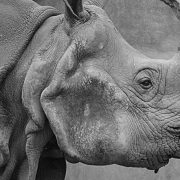|
Getting your Trinity Audio player ready...
|
By John Grobler and Khadija Sharife
First published on OCCRP
Major gaps between South African and Namibian legislation that regulates the endangered species trade allowed for the sale of at least 13 white rhino bulls from a South African game park to a Russian big game hunting outfit in Namibia. Nine of these rhinos were found to have died.
The sale was part of a controversial 2013 deal — which raised an outcry at the time — that saw a total of 260 of the endangered rhinos sold from South Africa’s Kruger National Park.
By itself, selling white rhinos is not an unusual practice. It’s a conservation strategy intended to raise money for parks, reduce poaching, and diversify the genetic pool by creating satellite populations in better-protected areas.
But a new investigation by Oxpeckers and the Organized Crime and Corruption Reporting Project (OCCRP) reveals that, in this case, something went dramatically wrong.
The fate of the rhinos that ended up in Namibia, the deaths of dozens more that were sold to South African breeding farms, and irregularities in the approval of the sale point to serious problems in how the conservation of endangered species is regulated — and highlight the ability of powerful individuals to skirt the rules to their benefit.
Worth more dead than alive?
Once on the brink of extinction, the South African population of white rhinos numbers about 22 000 (about 90% of the world total) as of 2010. Of these, some 75% are based in reserves such as Kruger National Park, while the remainder are housed on private land.
The recovery is thanks, in part, to the policy of SANParks, the country’s national parks agency, of sustainably selling rhinos to the commercial breeding industry to maintain genetic diversity.
That’s why, though the hunting of the animals for sport has a long and controversial history, many acknowledge that it has its place in conservation.
“In short, if there are no financial incentives for the private sector to breed white rhino, there might be a lot less investment overall,” explains Namibian rhino specialist Dr Pierre du Preez.
But the hunting industry has recently been infiltrated by a set of actors with a different agenda — killing the animals only in order to obtain and sell their horns.
“It’s sad, but rhinos are often worth more dead than alive,” says Namibian rhino breeder Jaco Muller.
That’s because the horns are worth more than the actual rhino. Each kilogram can fetch as much as US$100 000 — ultimately, as much as $300 000 per horn. The destination is China, where the horns are used to carve ornamental libation cups denoting superior social standing, or to Vietnam, where they are used as a hangover cure by the super-rich. The left-over bits are used in traditional Chinese medicine to cure everything from high blood pressure to rheumatism.
About 1 000 rhinos have been killed every year in South Africa in resurgent poaching — illegal hunting — since 2009. Most of these deaths take place in areas that straddle transnational borders, such as Kruger National Park.
Traditionally, such poaching has been carried out by organised crime cartels, which earn profits on the horns and use them for portable wealth.
But, as this investigation reveals, it’s not just illegal poachers that are the problem. People charged with protecting the animals are sometimes able to make use of gaps in legal regulations to profit from selling the animals, which in some cases leads to their deaths.
A number of rules govern the cross-border trade in rhinos between Namibia and South Africa, including local regulations in each country. Both countries are also party to the Convention on International Trade in Endangered Species of Wild Fauna and Flora, the oldest international conservation agreement that legally binds the voluntary participants.
South Africa has an additional set of Threatened or Protected Species (TOPS) laws that oversee the trade in endangered species.
These regulations prohibit the export of rhinos for anything but breeding or broader conservation purposes, and also prohibit hunting any rhino within three years of its being moved from an open to an enclosed area. But, as Du Preez explains, such regulations are not legally enforceable in neighbouring Namibia, which does not have a large indigenous rhino population. This is the loophole that has been exploited for the sake of handsome profits for South African and Russian billionaires.
It has also brought to light a fundamental problem in commercial breeding of white rhinos: Half of every annual cohort are males, for which there are no real markets except to be sold to the hunting industry as trophies.
Kruger’s rhino for Kruger’s rand
With an area of nearly two million hectares, the Kruger National Park in South Africa’s northern region is one of the continent’s largest game reserves. It is also where the most white rhinos have been poached since 2008.
In 2013, SANParks made a controversial decision to sell 500 white rhinos (later reduced to 260) to South African private game farms that were involved in the sports-hunting industry. Oxpeckers reported at the time that a SANpark official, Dr Hector Magome, had acted improperly in overseeing the deal, and that he had been suspended as a result.
Selling excess rhino bulls to be hunted is nothing new in the trophy hunting industry. Through special auctions and carefully curated and regulated sales, parks such as Kruger are allowed sell rhinos explicitly for hunting.
But that’s not what happened in this case.
According to documents obtained by OCCRP from a private investigator who specialises in rhino protection, the deal with the breeders appears to have been personally negotiated by Magome, rather than proceeding through the SANParks board, as is required for sales of over R10-million ($860 000).
Among the three South African breeders who were offered preferential access to the Kruger Park rhinos were South African billionaire Christo Wiese and his game-breeding partner Jacques Hartzenberg, co-owners of a farm called Kalahari Oryx. Taking advantage of the opportunity, Wiese and Hartzenberg bought an unknown number of rhinos on the cheap, at prices of R50 000 ($4 300) or more below average market-value.
The is despite the fact that prices for rhino hunting at private game reserves have been on the rise since 2014, as hunting quotas were reduced as a result of the increased poaching. Fees range from R825 000 ($70 000) to over R1-million ($85 000) for a trophy-quality bull, depending on the size of the main horn.)
Wiese then made a deal to sell some of the rhinos to the Marula hunting farm, a 29 500 hectare private reserve owned by Russian billionaire Rashid Sardarov near Namibia’s capital of Windhoek. Sardarov is a keen hunter, boasting trophies that include a critically-endangered black rhino.
A close examination of the deal between Kalahari Oryx and Sardarov brings to light anomalies that seem to have been overlooked in order to facilitate the Russian billionaire’s acquisition of the rhinos.
Marula’s general manager, Johan Kotze, interviewed at the farm with Sardarov’s regular hunting buddy and business associate Corné Kruger, said that his Russian boss had initially made a deal to buy 40 or 50 rhinos from Kalahari Oryx.
The animals, which he confirmed came from SANParks, were first kept at a farm in the South Africa’s Northern Cape province until Sardarov could complete the upgrade of a game proof fence at his farm, as required by Namibian legislation.
Sardarov ended up buying only 16 or 17 rhino bulls from Kalahari Oryx, two of which were swapped for cows. “The plan was to have 50 rhinos [on Marula, but Sardarov] refused to buy de-horned rhinos,” said Kotze to OCCRP, suggesting that Sardarov may have been more interested in the horns than the rhinos.
Also at issue was the fact that the price of the rhinos seems to have been determined by the size of their horn. While Kalahari Oryx had paid SANParks R15 000 ($1 250) per inch of horn for the rhinos, Sardarov paid R17 000 ($1 460) per inch of horn, Kotze said. “I can see how that creates an impression that they were sold for hunting purposes,” he admitted in an interview.
Reporters were able to confirm the delivery of 13 male rhinos to the Marula hunting farm from SANParks. More rhinos were planned for the farm, but SANParks halted the deal following the public outcry about the total sale.
While the South African TOPS regulations specify that endangered species such as white rhinos may only be exported for breeding purposes, the 13 rhinos supplied to Sardarov were all males, with no female companions.
Kotze conceded that importing only male rhinos could also create the impression that they had been imported for hunting purposes, but said only one rhino was hunted in October last year by prior agreement by Corné Kruger.
But Kruger, a controversial hunter recently expelled by the Namibia Professional Hunters Association (NAPHA), said that he had done three rhino hunts – including killing two critically-endangered black rhinos – with the Russian billionaire since then.
According to a manager he has since fired, Sardarov wanted to immediately hunt one of the new arrivals himself, but was convinced to wait the obligatory two years mandated by regulations.
In the end, nine of the rhinos imported by Marula allegedly died from contracting anthrax or fighting among each other. Dr Ulf Tubbesing, a veterinarian who attended to the rhinos, told OCCRP the problem was that an effective anti-anthrax vaccine for rhinos (Rhinovax) was only recently developed, after it became clear the bovine version was ineffective.
But at least two of the horns were not buried along with the rhinos, suggesting that they may have been kept for other purposes or sold.
Finally, South Africa’s Ministry of Environmental Affairs had only supported Marula’s application for nine rhinos, and issued nine import permits in 2014. Permits for the other animals may have been issued, said Du Preez, but these could not be independently verified, as such records are regarded as highly sensitive.
The sad story reveals a larger truth: It is often easier for wealthy individuals with privileged access to bend rules than adhere to regulations designed to protect endangered species – all in the name of commercially-sustainable conservation.
Trouble in transit
Many of the other sold rhinos sold by SANParks — the ones that stayed in South Africa — met similarly troubling fates.
A report obtained from a private investigator with ties to the rhino industry found that an unusually large number of animals — 130 of the 260 rhinos sold by the park — died in the relocation process between 2009 and 2014. These rhinos were then replaced by the park, as specified in the sales agreement between Magome, the SANParks official, and the breeders.
This number includes a significant number of the 90 rhinos sold to John Hume, owner of the world’s largest rhino farm near Klerksdorp, South Africa, which were reported to have died as a result of stress and unseasonably cold weather in 2013.
The sales agreements also specified that the horns of deceased rhinos had to be returned to SANParks for safe-keeping as an anti-poaching measure.
But, according to the report, as well as independent sources, there appears to be no evidence as to the fate of the horns of dozens of the dead rhinos, worth around $3-million.
A number of rhinos that did survive ended up in smaller, less secure farms or on farms with questionable reputations.
While SANParks vetted Hume as a responsible owner, as it does for all potential buyers, his choice of business partners at the time apparently did not set off any alarm bells.
Of Hume’s rhinos that survived, six ended up on the farm of Dawie Groenewald, a notorious rhino hunter known as “The Butcher” who is allegedly the mastermind of South Africa’s largest poaching syndicate. Groenewald and his brother Janneman are currently out on bail while fighting extradition to the US.
The US Department of Justice charged in 2014 that the Groenewald brothers had illegally sold rhino hunts to American clients under the pretence that the animals needed to be culled. The brothers face an 18-count indictment for alleged conspiracy, Lacey Act violations, mail fraud, and money laundering.
SANParks records, obtained by the private investigator, showed some of the other breeding farms where the remaining rhinos ended up were far too small (only 800 hectares in one case), lacking in grazing space, or exposed to poaching due to their proximity to densely-populated, low income areas.
Neither Wiese, nor Sadarov, nor the Department of Environmental Affairs and Tourism, which oversees SANparks, responded to questions posed by OCCRP.
Regulations overturned
John Hume, the world’s largest rhino farmer — who bought 90 of the Kruger rhinos in 2013 — has played a more recent, significant role in South Africa’s conservation regime.
In 2017, alongside Johan Kruger — a game farmer who did not breed rhinos at the time — Hume managed to overturn an eight-year ban on the domestic trade of rhino horns on a technicality, by arguing that restrictions hadn’t been sufficiently circulated in the national press.
The moratorium had been imposed in 2009 by the country’s Ministry of Environmental Affairs when it became evident that Chinese buyers were using the trophy hunting business to obtain horns. This was typically done by using proxies, often foreign women who act as hunters on behalf of the buyers. Dawie Groenewald has publicly boasted that he was behind Johan Kruger’s lawsuit.
Consequently, rhino horns can now be sold within South Africa, despite there being no domestic market for the product. Ultimately, these horns are smuggled to China and Vietnam where they are sold on the black market.
In this context, the “surplus” white rhinos present a lucrative opportunity, and one which raises questions about just how committed some SANParks insiders really are to the species’ conservation.
• This story is part of the Global Anti-Corruption Consortium, a partnership between OCCRP and Transparency International. For more information, click here.








